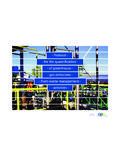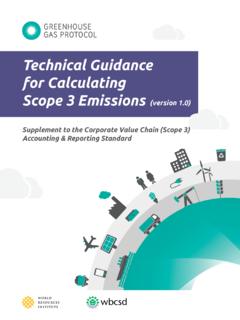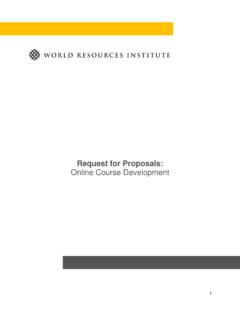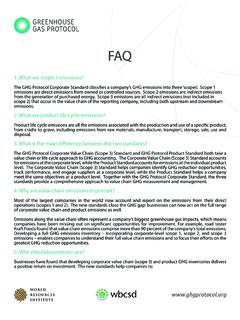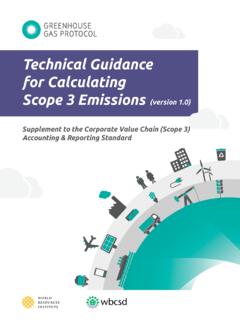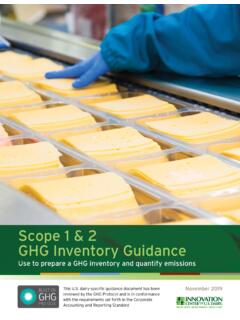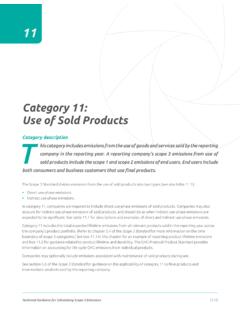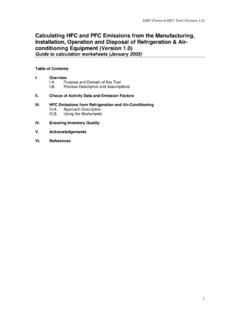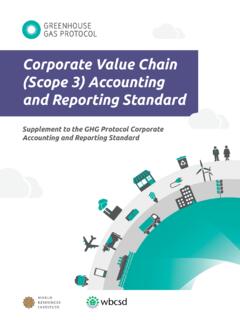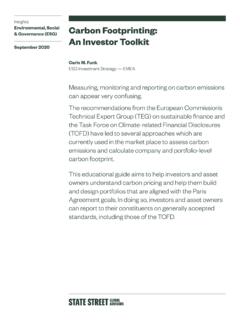Transcription of Product Life Cycle Accounting and Reporting Standard
1 Product Life Cycle Accounting and Reporting StandardGHG Protocol TeamPankaj Bhatia, World Resources InstituteCynthia Cummis, World Resources InstituteAndrea Brown, World Business Council for Sustainable DevelopmentLaura Draucker, World Resources InstituteDavid Rich, World Resources InstituteHolly Lahd, World Resources InstituteSteering CommitteeGerald Rebitzer, Amcor Topping, Frances Way, Carbon Disclosure Project (CDP)Graham Sinden, The Carbon TrustH. Scott Matthews, Carnegie Mellon UniversityLuc Larmuseau, DNV Climate Change ServicesDavid A. Russell, Rob Rouse, The Dow Chemical CompanyJiang Kejun, Energy Research Institute, China s National Development and Reform CommissionAndrew Hutson, Environmental Defense FundSimon Aum nier, Environmental Resources Management Ugo Pretato, Kirana Chomkhamsri, European Commission Joint Research CentreSteven Meyers, General ElectricSergio Galeano, Georgia Pacific, ISO TC207 Technical Advisory Group Gregory A.
2 Norris, Harvard University, New Earth, University of ArkansasKlaus Radunsky, ISO 14067 Working Group Convener Atsushi Inaba, Kogakuin UniversityAlison Watson, New Zealand Ministry of Agriculture and Forestry Susan Cosper, Nick Shufro, PricewaterhouseCoopers LLPR asmus Priess, THEMA1 GmbH, Product Carbon Footprint World Forum Wanda Callahan, Shell James A. Fava, UNEP SETAC Life Cycle Initiative, Five Winds InternationalMatthias Finkbeiner, UNEP SETAC Life Cycle Initiative, Technische Universit t BerlinHenry King, UnileverSusan Wickwire, John Sottong, United States Environmental Protection AgencyMaureen Nowak, United Kingdom Department of Environment, Food, and Rural AffairsJames Stanway, Miranda Ballentine, Walmart Stores Inc.
3 [01]guidanceguidanceguidanceguidancerequ irementsrequirementsguidancerequirements guidancerequirementsguidancerequirements guidancerequirementsguidancerequirements guidancerequirementsguidancerequirements guidancerequirementsguidancerequirements guidancerequirementsTable of ContentsCHAPTERS1. Introduction 022. Defining Business Goals 083. Summary of Steps and Requirements 124. Principles of Product Life Cycle GHG Accounting and Reporting 185. Fundamentals of Product Life Cycle GHG Accounting 206. Establishing the Scope of a Product Inventory 267. Boundary Setting 328. Collecting Data and Assessing Data Quality 469. Allocation 6010. Assessing Uncertainty 7811.
4 Calculating Inventory Results 8412. Assurance 9213. Reporting 10014. Setting Reduction Targets and Tracking Inventory Changes 108 APPENDICES A. Guidance on Product Comparison 115B. Land-Use Change Impacts 117C. Data Management Plan 126 Abbreviations 132 Glossary 133 References 139 Recognitions 140 Introduction01guidanceguidance[03]Introd uctionEmissions of the anthropogenic greenhouse gases (GHG) that drive climate change and its impacts around the world are growing. According to climate scientists, global carbon dioxide emissions must be cut by as much as 85 percent below 2000 levels by 2050 to limit global mean temperature increase to 2 degrees Celsius above pre-industrial Temperature rise above this level will produce increasingly unpredictable and dangerous impacts for people and ecosystems.
5 As a result, the need to accelerate efforts to reduce anthropogenic GHG emissions is increasingly urgent. Existing government policies will not sufficiently solve the problem. Leadership and innovation from business is vital to making progress. Corporate action in this arena also makes good business sense. By addressing GHG emissions, companies can identify opportunities to bolster their bottom line, reduce risk, and discover competitive advantages. As impacts from climate change become more frequent and prominent, governments are expected to set new policies and provide additional market-based incentives to drive significant reductions in emissions.
6 These new policy and market drivers will direct economic growth on a low-carbon trajectory. Businesses need to start planning for this transition now as they make decisions that will lock in their investments for years to effective corporate climate change strategy requires a detailed understanding of a company s GHG impact. A corporate GHG inventory is the tool to provide such an understanding. It allows companies to take into account their emissions-related risks and opportunities and focus company efforts on their greatest GHG impacts. Until recently, companies have focused their attention on emissions from their own operations. But increasingly companies understand the need to also account for GHG emissions along their value chains and Product portfolios to comprehensively manage GHG-related risks and opportunities.
7 Through the development of the GHG Protocol Product Standard , the GHG Protocol has responded to the demand for an internationally accepted method to enable GHG management of companies goods and services. Following the release of this Standard , the GHG Protocol and its partners will proactively work [04] Product Life Cycle Accounting and Reporting Standardguidancewith industry groups and governments to promote its widespread use along with the entire suite of GHG Protocol standards and tools to enable more effective GHG management worldwide. The Greenhouse Gas Protocol The Greenhouse Gas (GHG) Protocol is a multistakeholder partnership of businesses, non-governmental organizations (NGOs), governments, and others convened by the World Resources Institute (WRI) and the World Business Council for Sustainable Development (WBCSD).
8 Launched in 1998, the mission of the GHG Protocol is to develop internationally accepted greenhouse gas (GHG) Accounting and Reporting standards and tools, and to promote their adoption in order to achieve a low emissions economy GHG Protocol follows a broad, inclusive, consensus-based multi-stakeholder process to develop these standards with balanced participation from businesses, government agencies, non-governmental organizations, and academic institutions from around the world. The standards include detailed guidance to assist users with implementation and are freely available on the GHG Protocol website ( ). The GHG Protocol has produced the following separate, but complementary standards, protocols, and guidelines: GHG Protocol Corporate Accounting and Reporting Standard (2004): A standardized methodology for companies to quantify and report their corporate GHG emissions.
9 Also referred to as the Corporate Standard . GHG Protocol Corporate Value Chain (Scope 3) Accounting and Reporting Standard (2011): A standardized methodology for companies to quantify and report their corporate value chain (scope 3) GHG emissions, to be used in conjunction with the Corporate Standard . Also referred to as the Scope 3 Standard . GHG Protocol for Project Accounting (2005): A guide for quantifying reductions from GHG-mitigation projects. Also referred to as the Project Protocol. GHG Protocol for the Public Sector (2010): A step-by-step approach to measuring and Reporting emissions from public sector organizations, complementary to the Corporate Standard .
10 GHG Protocol Guidelines for Quantifying GHG Reductions from Grid-Connected Electricity Projects (2007): A guide for quantifying reductions in emissions that either generate or reduce the consumption of electricity transmitted over power grids, to be used in conjunction with the Project Protocol. [05]CHAPTER 01 Introductionguidance GHG Protocol Land Use, Land-Use Change, and Forestry Guidance for GHG Project Accounting (2006): A guide to quantify and report reductions from land use, land-use change, and forestry, to be used in conjunction with the Project Protocol. measuring to Manage: A Guide to Designing GHG Accounting and Reporting Programs (2007): A guide for program developers on designing and implementing effective GHG programs based on accepted standards and methodologies .
